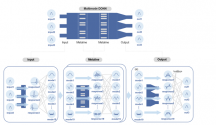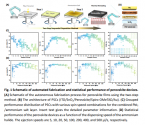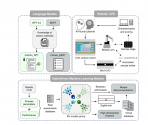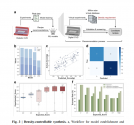Nanjiang anticipates building data center with 250k mainframe and 8.5EFLOPS (FP32) computation with 6EFLOPS (FP16) intelligent computing power and storage capacity of 60EB. will serve Yangtze river delta area with 3ms low latency and Nanjing area with 1ms latency
You are using an out of date browser. It may not display this or other websites correctly.
You should upgrade or use an alternative browser.
You should upgrade or use an alternative browser.
Artificial Intelligence thread
- Thread starter 9dashline
- Start date
Multimode diffractive optical neural network: A new style photonic accelerator
Researchers from Tsinghua University and National University of Defense Technology achieved optical neural network by manipulating the mode coupling in a subwavelength etched structure within confined spaces.

The diffractive optical neural network (DONN) has attracted extensive attention from researchers due to the significantly higher density of modulating units compared to some traditional devices. Passive modulating units manipulate the propagation of optical waves in the DONN. The computational processes are achieved through the diffraction and interference of light.
Recently, Prof. Hongwei Chen's research group from Tsinghua University and the research team from National University of Defense Technology jointly published the work of multimode diffractive optical neural networks in the Advanced Photonics Nexus journal, introducing a novel optical diffraction computing structure that incorporates modulating units into confined spaces. The key distinction from previous research lies in the constraint of light propagation in confined space. The previous work needs to ensure a longer distance between the hidden layers to establish the approximation conditions, and the light reflection at the spatial boundaries introduces complex factors for diffraction-based analytical methods. By contrast, this work effectively solves the above problems, and the more compact computational space also effectively controls the energy dissipation between the modulating structure layers.
Researchers opted for an alternative modeling approach, namely the eigenmode analysis method. Within confined spaces, the modulating layer forms a mode coupling structure, where multiple modes undergo coupling after passing through the modulating layers. This coupling behavior is described by a mode coupling matrix. Similarly, input and output structures are modeled as coupling rules between ports and modes.
By simply continuously multiplying the mode coupling matrix, the linear port-to-port transmission matrix of the entire DONN can be quickly and accurately obtained. Based on the standard SOI structure, a set of modulating layers is constructed through a binary design scheme in the multimode waveguide. Through simulation demonstration, the coupling process of the transverse electric modes in these structures is described by the mode coupling matrix. By selecting the most suitable structures and combining them, the multimode DONN is applied to tasks such as iris flower classification and one-bit adder. It exhibits advantages in terms of power consumption and footprint compared to the structures previously investigated.
my thoughts on hyperscaling and AI
as far as I know, only bytedance so far is committing to probably hundred of EFLOPS of computation power
But the limiting factor will be size of models (# of parameters) rather than computation. Don't really see the need for 1000 EFLOPS hardware
as far as I know, only bytedance so far is committing to probably hundred of EFLOPS of computation power
But the limiting factor will be size of models (# of parameters) rather than computation. Don't really see the need for 1000 EFLOPS hardware
The West may have the generals to fight the tech war but they lack the soldiers to do so. China has cultivated the world's largest technical and scientific workforce. For most part these people are not the smartest one percent of the PhD's but are just people with a technical degree from a university or technical college. But they are the ones literally and figuratively with their sleaves rolled up installing 5G basestations, service robots in factories, EV recharging stations, building high speed railway lines etc. Not only installing them but also running them and maintenancing them. This means that China is far faster and more broad in its implementation of new technologies.Reality finally dawn on the American, they can't compete especially in the A.I engineer Talents, the core ingredient.
1 hour ago — (The New York Times has sued OpenAI and Microsoft for copyright infringement of news content related to A.I. systems.) China has nurtured so ...
If the smartest one percent of the PhD's are the feldmarschalls and generals of the tech war these guys are the foot soldiers with a gun at the front.
New public AI computation platform is launched in Beijing, the largest in Beijing thus far, providing 3000PFLOPS computation
This particular area aims to have 10000PFLOPS computation and 100 industrial chain company by 2026.
Chongqing is looking to have its first AI industrial fund, raising 1B initially
This particular area aims to have 10000PFLOPS computation and 100 industrial chain company by 2026.
Chongqing is looking to have its first AI industrial fund, raising 1B initially
Precise Control of Process Parameters for >23% Efficiency Perovskite Solar Cells in Ambient Air Using an Automated Device Acceleration Platform
Abstract: Achieving high-performance perovskite photovoltaics, especially in ambient air relies heavily on optimizing process parameters. However, traditional manual methods often struggle to effectively control the key variables. This inherent challenge requires a paradigm shift toward automated platforms capable of precise and reproducible experiments. Herein, we use a fully automated device acceleration platform (DAP) to optimize the process parameters for preparing full perovskite devices using a two-step method in ambient air. Eight process parameters that have the potential to significantly influence device performance are systematically optimized. Specifically, we delve into the impact of the dispense speed of organic ammonium halide, a parameter that is difficult to control manually, on both perovskite film and device performance. Through the targeted design of experiments, we reveal that the dispense speed significantly affects device performance primarily by adjusting the residual PbI2 content in the films. We find that moderate dispense speeds, e.g., 50 µl/s, contribute to top-performance devices. Conversely, too fast or too slow speeds result in devices with relatively poorer performance and lower reproducibility. The optimized parameter set enables us to establish a Standard Operation Procedure (SOP) for additive-free perovskite processing under ambient conditions, which yield devices with efficiencies surpassing 23%, satisfactory reproducibility, and state-of-the-art photo-thermal stability. This research underscores the importance of understanding the causality of process parameter sin enhancing perovskite photovoltaic performance. Furthermore, our study highlights the pivotal role of automated platforms in discovering innovative workflows and accelerating the development of high performing perovskite photovoltaic technologies.



